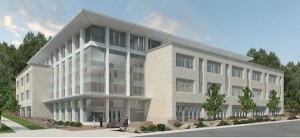by Doris White
The Church of Jesus Christ of Latter-day Saints was organized on April 6, 1830, in New York. At this organization, the Lord revealed to Joseph Smith a commandment that the Saints should keep a record of the history of the Church (Doctrine and Covenants 21:1). Later it became a position in the Church—Church Historian—to be in charge of the record kept. This commandment applies individually as well. Church members are encouraged to keep personal journals of their lives and of the Lord’s hand in their lives.

New Church History Library
Today the Church Historian and Recorder is Elder Steven Snow of the Seventy, who replaced Marlin Jensen as historian in 2012.
Marlin Jensen, when he was originally called to serve as historian in 2005, seemed an unlikely choice because of his lack of experience in the field. However, he threw himself into the task and accomplished significant things, including overseeing the groundbreaking for the Joseph Smith Papers Project (an initiative to research, collect, and publish all manuscripts and documents created by or under the direction of the Prophet Joseph Smith, which will take several years to complete), putting thousands of the Church’s documents online, reorganizing the staff and moving them into a new, state-of-the-art building (see below), and insisting on an open and honest account being laid forth of the controversial Mountain Meadows Massacre.
Jensen said of the importance of keeping records, “The primary purpose of Church history is to help Church members build faith in Jesus Christ and keep their sacred covenants” (“Giving the Past a Future,” Ensign, October 2009, 42). The Church recently completed a new facility in which to store all these records. The new Church History Library was dedicated in June 2009 and is located in downtown Salt Lake City, just to the east of the Conference Center. The close location to both the Family History Library and to the Church History Museum gives patrons easy access to countless documents.
“Marlin Jensen has done more to further the cause of Mormon history than any person of the current generation,” said Terryl Givens, an LDS writer and professor of literature and religion at the University of Richmond in Virginia. “He will be missed as much for the quality of his character as for his contributions. His unflinching honesty and his confidence that church history needed no whitewashing or sanitizing set the tone for a whole new generation of LDS academics” (“Changing of the Guard in Mormon History,” Peggy Fletcher Stack, Salt Lake Tribune, January 19, 2012).
The standard for accuracy in Church history has not decreased since Elder Snow’s call. Assistant Church Historian Richard E. Turley, Jr., received the prestigious 2013 Herbert Feis Award from the American Historical Association, recognizing his significant contributions in guiding the Church’s history operations which include archives, museums, 25 historic sites, and an almost unparalleled records management system.
During Turley’s time as a leader the Church History Department, the department developed and continued to exact high-level standards focusing on the acquisition, organization, preservation, and dissemination of materials relating to the founding and development of the Church. No matter who is currently in charge of the Church History Department, the task is huge.
Leaders of the Church have long recognized that the history of the Church involves much more than just dates and names, but rather encompasses the history of all its people. Members from all around the world, from the time of the First Vision in 1820 to the present, have had faith-building, spiritual experiences which have contributed to the building of the kingdom of God on the earth. People have made sacrifices, have made covenants, and have been richly blessed, knowing their stories can strengthen the faith of Church members today.
The Church History Library provides nearly 25 miles of shelving to store all kinds of records: books, journals, photographs, microfilm, other media, and miscellaneous documents. The library’s old facilities in the Church Office Building were inadequate in size and scope. Now the library has the proper facilities to provide adequate temperature, humidity, and air-quality control to precious documents, plus fire and seismic protection.

New Church History Library Lobby
It is not only the goal of library staff to collect and store important Church documents, but to provide these documents to researchers, who might be professionals or amateurs. Archivists don’t want to simply preserve this information; they want people to use this information. Patrick Dunshee, manager of marketing and communications for the Church History Department explains, “Our desire is to help patrons increase their faith as they connect to their past” (“Giving the Past a Future,” Ensign, October 2009, 20). Family history can be conducted here which can bring new life and meaning by looking at personal records and pictures. When records were moved to the new building, every item was given a bar code and was scanned, thus enabling much more efficient and effective research and maintenance. Though not everything is open to public access, due to considerations such as privacy, confidentiality, and copyright laws, patrons are given access to the library catalogs and indexes. With 125 employees and nearly 200 full-time and Church-service missionaries, ample research help is also available. The library will also be offering myriad programs to teach people more about the resources available.
Sources:
Changing of the guard in Mormon history
Church Historian Receives Prestigious History Award
Assistant Church Historian Honored by National Group
President Henry B. Eyring shares his experiences of keeping a daily journal:


 Watch a video about the restoration of the gospel on lds.org
Watch a video about the restoration of the gospel on lds.org